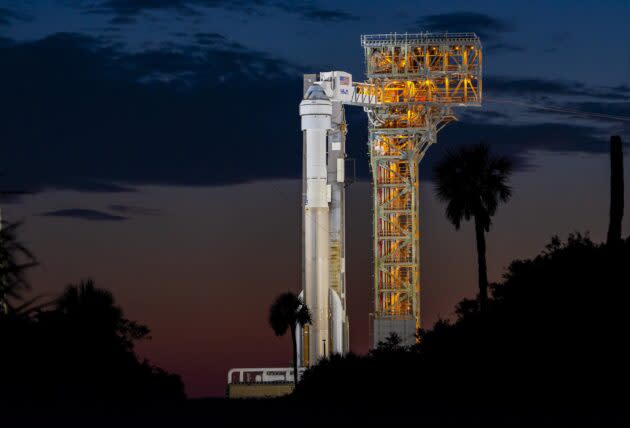
NASA and its commercial partners are counting down once more to a launch aimed at sending Boeing’s Starliner space capsule to the International Space Station — with a living, breathing crew on board for the very first time.
The gumdrop-shaped capsule is due to rise into space atop a United Launch Alliance Atlas V rocket, with liftoff from Cape Canaveral Space Force Station in Florida set for 12:25 p.m. ET (9:25 a.m. PT) today. The prospects for acceptable weather have been set at 90%. Launch coverage is streaming via NASA’s website and YouTube.
After NASA astronauts Butch Wilmore and Sunita Williams climbed into the capsule, mission managers reported that United Launch Alliance was looking into an issue relating to fuel-topping valves for the Atlas V’s Centaur upper stage. Engineers worked to switch over to a backup control system. “We expect that to resolve the issue,” ULA launch commentator Dillon Rice said.
If everything goes according to plan, Wilmore and Williams will ride Starliner into low Earth orbit and rendezvous with the space station a little more than 25 hours after launch. During their 10-day trip, they’ll check out Starliner’s systems and deliver supplies to the space station — including a replacement pump for the system that the station’s crew uses to convert urine into drinkable water. Then they’ll head back down to Earth.
Everything hasn’t always gone according to plan with Starliner. Boeing’s spacecraft development effort has encountered years of delays and more than $1 billion in cost overruns that the company has had to cover.
Starliner’s first uncrewed flight test fell short of full success in 2019, forcing a second uncrewed test that met its objectives in 2022.
The most recent round of problems cropped up during a previous launch attempt on May 6. Mission managers called off the countdown two hours before launch, due to a balky oxygen relief valve on the rocket’s Centaur upper stage. In the course of resolving that issue, engineers detected a small helium leak that was traced to a flange on one of the Starliner service module’s thrusters.
NASA and Boeing spent days assessing the leak’s potential impact, and the team decided the safest course of action was to live with the leak and work around it.
“It’s a really, really small leak, and it’s well within the margin that we have,” said Steve Stich, program manager for NASA’s Commercial Crew Program.
During a pre-launch briefing, Stich said the flange was at a spot in the thruster system where the lines for fuel, oxidizer and helium for pressurization come together. “It makes it almost unsafe to work on,” he said.
Engineers also learned of a potential design vulnerability in Starliner’s propulsion system — an issue that could hamper the capsule’s ability to execute a deorbit burn if two of the four thruster units known as “doghouses” were to fail at the same time.
The mission team developed a work-around for the test flight. After the return of Starliner and its crew, NASA and Boeing will take a closer look at the propulsion system design, and at the leaky helium pressurization system.
Yet another concern came to light at the end of a crewed suborbital space mission that was conducted by Jeff Bezos’ Blue Origin space venture on May 19. When the New Shepard crew capsule descended toward touchdown, one of its three parachutes failed to open completely. Starliner’s parachute system uses a similar design, so NASA and Boeing worked with Blue Origin to make sure the problem wouldn’t crop up during the orbital test mission.
Stich said Blue Origin traced the parachute problem to a reefing line that’s designed to keep the parachute from opening prematurely. There’s a mechanism that’s supposed to cut the line at the proper moment, but Stich said “the cutters, for some reason, did not cut that line.”
“We use a very similar cutter to what Blue Origin uses, so it was important for us to look at that data,” Stich said. “We went back and looked at all of our test data.”
Stich said the Starliner system’s cutters had been successfully tested 160 times, which reassured the team that the parachutes were good to go.
NASA made a last-minute switch in the payloads for Starliner’s test flight: The pump for the space station’s urine-recycling system failed unexpectedly, forcing the crew to store their urine in bags and tanks. NASA decided to provide some relief, so to speak, by sending up a 150-pound replacement tank in Boeing’s capsule. To keep Starliner’s mass distribution in balance, two suitcases containing clothing and personal hygiene items for Wilmore and Williams are being left behind.
“They’ll just use our generic supplies that we have on board,” said Dana Weigel, who manages NASA’s International Space Station Program. “The reason why we have them there is for cases like this.”
After spending around eight days on the space station, Wilmore and Williams will ride Starliner back down for a parachute-aided, airbag-cushioned landing in the American Southwest, at a site to be determined based on the weather and the timing of the return.
Boeing will use the data gathered during the test flight to fine-tune its spacecraft design. Those refinements should clear the way for Starliner to take its place alongside SpaceX’s Crew Dragon as a commercial “space taxi” that’s capable of ferrying astronauts to and from orbit.
That’s assuming, of course, that everything goes according to plan.
More from GeekWire:
Signup bonus from



